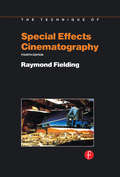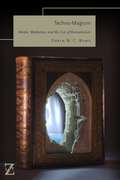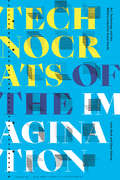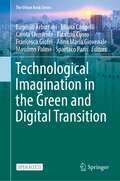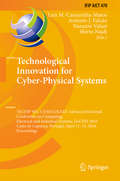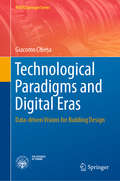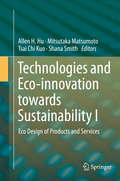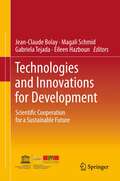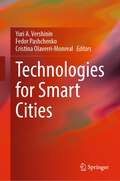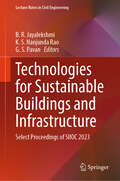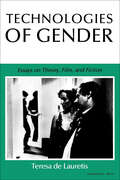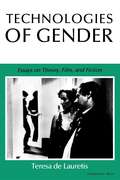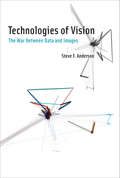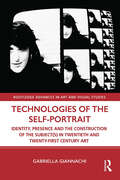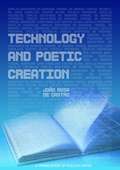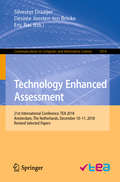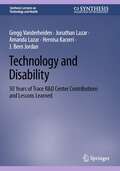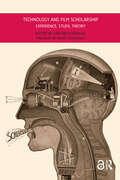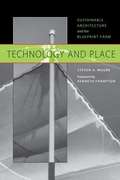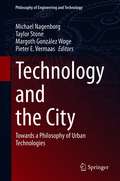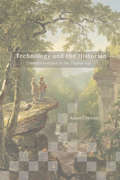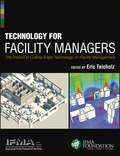- Table View
- List View
Techniques of Special Effects of Cinematography (Library Of Communication Techniques)
by Raymond FieldingFirst published in 1985. Exactly 20 years have passed since the first edition of this text appeared, in 1965. During this period, the author has gathered feedback from professional film-making circles. This fourth revision introduces new information in nearly all chapters. 130 new illustrations have been added, many of them illustrating feature films which are currently in release. The bibliography has also been enlarged considerably. The contributions of the visual-effects cinematographer have always been valued highly within the theatrical motion-picture industry. Because of their work, film producers have been able to endow their pictures with considerable 'production value' which the budget could not otherwise sustain.
Techno-Magism: Media, Mediation, and the Cut of Romanticism (Lit Z)
by Orrin N. WangShortlisted, Marilyn Gaull Book AwardTechno-Magism explores how British Romantic literature abuts and is organized around both print and non-print media. The book explores not only the print, pictorial art, and theater of early nineteenth-century England and Europe but also communicative technologies invented after the British Romantic period, such as photography, film, video, and digital screens. This proleptic abutting points to one way we can understand the implicit exceptionality wagered by reading Romanticism through media studies and media theory.Techno-Magism argues that both media studies and the concept of mediation in general can benefit from a more robust confrontation with, or recovery of, the arguments of deconstruction, an unavoidable consequence of thinking about the relationship between Romanticism and media. The book thinks that relationship through the catachrestic practice of a techno-magism, a technics of inscription always outside the causalities of a dialectical economy. The book further pursues two interrelated ideas: the structural incommensurability of the cut and the unapologetic presentism of the constellation. Marked by its late capitalist moment of composition, the book explores the continuity between the social character of Romantic and post-Romantic media, in terms of commodity culture, revolution, and the ecological devastation of the anthropocene.
Techno-Orientalism
by Jinny Huh Catherine Fung Abigail De Kosnik Seo-Young Chu Dylan Yeats Kathryn Allan Julie Ha Tran Aimee Bahng Jason Crum Tzarina T. Prater Douglas S. Ishii Greta A. Niu Kenneth Hough Betsy Huang Se Young Kim Warren Liu Victor Bascara David S. Roh Steve Choe Charles ParkWhat will the future look like? To judge from many speculative fiction films and books, from Blade Runner to Cloud Atlas, the future will be full of cities that resemble Tokyo, Hong Kong, and Shanghai, and it will be populated mainly by cold, unfeeling citizens who act like robots. Techno-Orientalism investigates the phenomenon of imagining Asia and Asians in hypo- or hyper-technological terms in literary, cinematic, and new media representations, while critically examining the stereotype of Asians as both technologically advanced and intellectually primitive, in dire need of Western consciousness-raising. The collection's fourteen original essays trace the discourse of techno-orientalism across a wide array of media, from radio serials to cyberpunk novels, from Sax Rohmer's Dr. Fu Manchu to Firefly. Applying a variety of theoretical, historical, and interpretive approaches, the contributors consider techno-orientalism a truly global phenomenon. In part, they tackle the key question of how these stereotypes serve to both express and assuage Western anxieties about Asia's growing cultural influence and economic dominance. Yet the book also examines artists who have appropriated techno-orientalist tropes in order to critique racist and imperialist attitudes. Techno-Orientalism is the first collection to define and critically analyze a phenomenon that pervades both science fiction and real-world news coverage of Asia. With essays on subjects ranging from wartime rhetoric of race and technology to science fiction by contemporary Asian American writers to the cultural implications of Korean gamers, this volume offers innovative perspectives and broadens conventional discussions in Asian American Cultural studies.
Technocrats of the Imagination: Art, Technology, and the Military-Industrial Avant-Garde (a Cultural Politics book)
by John Beck Ryan BishopIn Technocrats of the Imagination John Beck and Ryan Bishop explore the collaborations between the American avant-garde art world and the military-industrial complex during the 1960s, in which artists worked with scientists and engineers in universities, private labs, and museums. For artists, designers, and educators working with the likes of Bell Labs, the RAND Corporation, and the Los Angeles County Museum of Art, experiments in art and technology presaged not only a new aesthetic but a new utopian social order based on collective experimentation. In examining these projects' promises and pitfalls and how they have inspired a new generation of collaborative labs populated by artists, engineers, and scientists, Beck and Bishop reveal the connections between the contemporary art world and the militarized lab model of research that has dominated the sciences since the 1950s.
Technological Imagination in the Green and Digital Transition (The Urban Book Series)
by Massimo Palme Eugenio Arbizzani Eliana Cangelli Carola Clemente Fabrizio Cumo Francesca Giofrè Anna Maria Giovenale Spartaco ParisThis open access book addresses the pressing need for sustainability in urban development and the use of technology, with cities to serve as the main stage for strategies that seek to meet the targets and the cross-sector priorities indicated in the EU’s Next Generation program, all in pursuit of a solid recovery on the part of the European economy, along lines of ecological transition, digitalization, competitiveness, training, and inclusion to overcome social, territorial, and gender differences.The international study encounter is meant to promote visions shared by architectural technology and other disciplines, which, though they may appear to differ, are closely interconnected, with the aim of achieving an open, interdisciplinary integration capable of proposing concrete projects regarding topics held to be of strategic importance to the future of the built environment. These are identified to draw up evolving scenarios of architecture and cities suited to reflection, at various levels, on innovative models of process and product.
Technological Innovation for Cyber-Physical Systems
by Luis M. Camarinha-Matos António J. Falcão Nazanin Vafaei Shirin NajdiThis book constitutes the refereed proceedings of the 7th IFIP WG 5. 5/SOCOLNET Advanced Doctoral Conference on Computing, Electrical and Industrial Systems, DoCEIS 2016, held in Costa de Caparica, Portugal, in April 2016. The 53 revised full papers were carefully reviewed and selected from 112 submissions. The papers present selected results produced in engineering doctoral programs and focus on research, development, and application of cyber-physical systems. Research results and ongoing work are presented, illustrated and discussed in the following areas: enterprise collaborative networks; ontologies; Petri nets; manufacturing systems; biomedical applications; intelligent environments; control and fault tolerance; optimization and decision support; wireless technologies; energy: smart grids, renewables, management, and optimization; bio-energy; and electronics.
Technological Paradigms and Digital Eras: Data-driven Visions for Building Design (PoliTO Springer Series)
by Giacomo ChiesaThe book connects the ICT and the architectural worlds, analyzing modeling, materialization and data-driven visions for design issues at different scales. Furthermore, using sample modeling and materialization tools, it explores the links between performance-driven design approaches and the application of new digital technologies. Intended for architects and urbanists, it provides a theoretical framework to address the implications of the digital revolution in building design and operation. Furthermore, combining insights from IT and ICT with architectural and urban design know-how, it offers engineering professionals a technology-driven interpretation of the building design field.
Technologies and Eco-innovation towards Sustainability I: Eco Design of Products and Services
by Mitsutaka Matsumoto Allen H. Hu Tsai Chi Kuo Shana SmithThis 2-volume book covers the state-of-the-art of the research and practices on eco-design. It covers the latest topics in the field: e.g. global eco-design management, big data in eco-design, social perspectives in eco-design; as well as emphasizing the developments in emerging economies such as Asian countries. Eco-design of products and product-related services are indispensable to realize the circular economy and to increase resource efficiencies of our society. Eco-design practices are necessary both in developed countries and developing countries. The book chapters are contributed by the worldwide authors, especially authors from East Asian countries, European countries, and Southeast Asian countries, and contains selected presentations at the EcoDesign2017 symposium (10th International Symposium on Environmentally Conscious Design and Inverse Manufacturing). The first volume highlights products and services, the chapters include the product life cycle design and business strategy, technologies for the future and sustainability, as well as social perspectives in eco-design.
Technologies and Innovations for Development
by Alexandre Schmid Eileen Hazboun Jean-Claude Bolay Gabriela TejadaTechnological innovation - combined with scientific research - has always constituted a driving force of transformation in our societies. At the same time, it is no longer simply possible to transfer technologies from the North to the South; it is also essential to consider technical innovations that are adapted to the social, environmental, cultural and economic conditions of receiving countries, and which can be appropriated by their potential users and as such prove to be real technologies for fostering development. The first International Scientific Conference on the topic organized by the UNESCO Chair Technologies for Development at the Ecole Polytechnique Fédérale de Lausanne in 2010 focused on its four priority sectors: Technologies for Sustainable Development of Habitat and Cities, ICTs for the Environment, Science and Technology for Disaster Risk Reduction, and Technologies for the Production of Sustainable Energy. This volume reflects the main outcomes of the conference and provides some significant orientation and success criteria for the effective implementation and use of innovative technologies, their aims, their particular applications in the context of developing countries, their accessibility for users, and their appropriation by producers and stakeholders in the field of development both in the North and South, thus ensuring their sustainability. This kind of scientific cooperation also highlights the added values for northern researchers in sharing their knowledge and know-how, leading to a real win-win partnership. The authors gathered within this book include representatives from academic and research institutions and other organizations from diverse countries and offer a significant synergy of competences, approaches and disciplines.
Technologies for Smart Cities
by Yuri A. Vershinin Fedor Pashchenko Cristina Olaverri-MonrealThis book gives readers an overview about technologies that are useful for developments related to Smart Cities.Some technologies are already available, such for example, as smart meters for electricity and gas in buildings. But there are possibilities to incorporate existing devices into wider networks with other smart devices that currently operate independently. This in turn will considerably improve the reduction of the energy consumption in buildings, reduction of emission pollutions in cities and improvement of the well-being of people. The other objective of this book is to introduce readers to new technologies which are not yet implemented in areas related to the efficient functioning of cities. For example, areas related to Intelligent Transport Systems are mostly developed for the optimization of the traffic flow, reduction of accidents on roads, improvement of the safety of drivers and related to road transportation problems. The rapid advances in Blockchain technologies are also covered.
Technologies for Sustainable Buildings and Infrastructure: Select Proceedings of SIIOC 2023 (Lecture Notes in Civil Engineering #528)
by B. R. Jayalekshmi K. S. Nanjunda Rao G. S. PavanThis book presents select proceedings of the International Conference on Sustainable Infrastructure: Innovations, Challenges and Opportunities 2023 (SIIOC 2023). The topics covered include behavior of masonry and RC buildings under earthquakes, performance of concrete, bricks and blocks manufactured with non-organic industrial wastes, bamboo for construction, composites for construction, and finite element simulations on buildings and special structures. The book presents various facets of experiments to characterize the properties of construction materials and intricacies involved in performing finite element simulations to assess the behavior of buildings under seismic and wind loading conditions. The book serves as a resource material for budding researchers and industry professionals interested in developing solutions for sustainable building habitats.
Technologies of Gender: Essays On Theory, Film, And Fiction
by Teresa de de Lauretis"Technologies of Gender builds a bridge between the fashionable orthodoxies of academic theory (Lacan, Foucault, Derrida, et al.) and the frequently-marginalized contributions of feminist theory.... In sum, de Lauretis has written a book that should be required reading for every feminist in need of theoretical ammunition--and for every theorist in need of feminist enlightenment." --B. Ruby Rich"... sets philosophical ideas humming.... she has much to say." --Cineaste"I can think of no other work that pushes the debate on the female subject forward with such passion and intellectual rigor." --SubStanceThis book addresses the question of gender in poststructuralist theoretical discourse, postmodern fiction, and women's cinema. It examines the construction of gender both as representation and as self-representation in relation to several kinds of texts and argues that feminism is producing a radical rewriting, as well as a rereading, of the dominant forms of Western culture.
Technologies of Gender: Essays on Theory, Film, and Fiction
by Teresa De LauretisWhile all the essays in the volume imply the feminist perspective articulated in "Alice Doesn't", a development may be seen to have taken place (especially in essays 1, 7, and 8) with regard to the understanding of feminism as a radical rewriting, as well as a rereading, of the dominant forms of Western culture; a rewriting which effectively inscribes the presence of a different, and gendered, social subject. But even so, what these essays propose and argue for is a continued testing of the boundaries, an essaying of the no-man's land inhabited by "Alice," rather than a fully constructed view from "elsewhere."
Technologies of Vision: The War Between Data and Images (The\mit Press Ser.)
by Steve F AndersonAn investigation of the computational turn in visual culture, centered on the entangled politics and pleasures of data and images.If the twentieth century was tyrannized by images, then the twenty-first is ruled by data. In Technologies of Vision, Steve Anderson argues that visual culture and the methods developed to study it have much to teach us about today's digital culture; but first we must examine the historically entangled relationship between data and images. Anderson starts from the supposition that there is no great divide separating pre- and post-digital culture. Rather than creating an insular field of new and inaccessible discourse, he argues, it is more productive to imagine that studying “the digital” is coextensive with critical models—especially the politics of seeing and knowing—developed for understanding “the visual.”Anderson's investigation takes on an eclectic array of examples ranging from virtual reality, culture analytics, and software art to technologies for computer vision, face recognition, and photogrammetry. Mixing media archaeology with software studies, Anderson mines the history of technology for insight into both the politics of data and the pleasures of algorithms. He proposes a taxonomy of modes that describe the functional relationship between data and images in the domains of space, surveillance and data visualization. At stake in all three are tensions between the totalizing logic of data and the unruly chaos of images.
Technologies of the Self-Portrait: Identity, Presence and the Construction of the Subject(s) in Twentieth and Twenty-First Century Art (Routledge Advances in Art and Visual Studies)
by Gabriella GiannachiThis book demonstrates how artists have radically revisited the genre of the self-portrait by using a range of technologies and media that mark different phases in what can be described as a history of self- or selves-production. Gabriella Giannachi shows how artists constructed their presence, subjectivity, and personhood, by using a range of technologies and media including mirrors, photography, sculpture, video, virtual reality and social media, to produce an increasingly fluid, multiple, and social representation of their ‘self’. This interdisciplinary book draws from art history, performance studies, visual culture, new media theory, philosophy, computer science, and neuroscience to offer a radical new reading of the genre.
Technology And Poetic Creation
by João Rosa de CastroAn attempt to answer the question of scientific initiation: "can technological instruments change the meaning of poet and poetry?" Technology and poetic creation The objective of this work is to present, as much as possible, the network of relationships of technology and poetic composition, and was proposed in the Scientific Initiation program of the CCHSAE (Center for Human and Social Sciences, Arts and Education) at the Cruzeiro do Sul University, in 2003. Although these relations seem recent, due to the growing development of technologies, in the 20th century, the conclusions demonstrate that technology has always been present, in some way, as an extension of human activities. This indisputable presence starts from the need for technology for Education, Health and Politics, as a factor of social and digital inclusion, from the pencil, through the technological resources in the processes of artistic and cultural production, such as, for example, holography, reaching the electronic literary hypertext, where it finds its peak in Literature. The method of this research is predominantly inductive, with the characterization of facts and the establishment of principles and concepts, in the relations of individuals with technological instruments to improve the quality of poetic creation. The result is the deconstruction of oppositions, such as art x technology, technology x sensitivity, technology x creation; in a perception of how technological instruments, used in a coherent way, that is, as an extension of human action, and not the other way around, can be prime for the transformation of paradigms in the interpretation of reality or in the composition of their portraits. It is concluded, therefore, that despite this extension, often controversial, as it may suggest inertia itself, it is still up to humanity, being composed of cooperative individuals, regardless of the technological resources at hand, their socio-cultural impro
Technology Enhanced Assessment: 21st International Conference, TEA 2018, Amsterdam, The Netherlands, December 10–11, 2018, Revised Selected Papers (Communications in Computer and Information Science #1014)
by Desirée Joosten-ten Brinke Eric Ras Silvester DraaijerThis book constitutes the proceedings of the 21st International Conference on Technology Enhanced Assessment, TEA 2018, held in Amsterdam, The Netherlands, in December 2018. The 14 papers presented were carefully selected from 34 submissions. They are centered around topics like e-learning, computer-assisted instruction, interactive learning environments, collaborative learning, computing education, student assessment.
Technology and Disability: 50 Years of Trace R&D Center Contributions and Lessons Learned (Synthesis Lectures on Technology and Health)
by Jonathan Lazar Gregg Vanderheiden Amanda Lazar Hernisa Kacorri J. Bern JordanThis book outlines the development of the Trace R&D Center as an institution for furthering accessible and assistive technologies. The book walks readers through the Center’s nascent attempts to solve individual challenges with augmentative communication devices through contemporary efforts to establish global frameworks and infrastructures for accessibility. This book is premised on the Center’s mission to maximize the potential of people with disabilities by harnessing evolving technologies while at the same time dismantling the barriers created by those same technological advancements. Readers will learn how this has been done in the past and why this practice should be a fundamental and integrated feature in new technology planning and implementation. The book touches on pre-internet technologies before exploring the huge implications of, first, the personal computer and, second, the Internet. In parallel with the massive growth in scale rendered by the launch of the Web, the book traces the expansion of the Center’s focus from the individual to the universal, particularly in working to establish accessibility standards and infrastructures. Learning from the successes and failures of the Center, the book outlines many past challenges and future directions for the development of technologies for people with disabilities from the research and industry perspectives.
Technology and Film Scholarship: Experience, Study, Theory (Film Theory in Media History)
by André GaudreaultThis volume brings together a wide range of research on the ways in which technological innovations have established new and changing conditions for the experience, study and theorization of film. Drawn from the IMPACT film conference (The Impact of Technological Innovations on the Historiography and Theory of Cinema) held in Montreal in 2011, the book includes contributions from such leading figures in the field as Tom Gunning, Charles Musser, Jan Olsson and Vinzenz Hediger.
Technology and Place
by Steven A. MooreDeveloping "sustainable" architectural and agricultural technologies was the intent behind Blueprint Farm, an experimental agricultural project designed to benefit farm workers displaced by the industrialization of agriculture in the Rio Grande Valley of Texas. Yet, despite its promise, the very institutions that created Blueprint Farm terminated the project after just four years (1987-1991). In this book, Steven Moore demonstrates how the various stakeholders' competing definitions of "sustainability," "technology," and "place" ultimately doomed Blueprint Farm. He reconstructs the conflicting interests and goals of the founders, including Jim Hightower and the Texas Department of Agriculture, Laredo Junior College, and the Center for Maximum Potential Building Systems, and shows how, ironically, they unwittingly suppressed the self-determination of the very farm workers the project sought to benefit. From the instructive failure of Blueprint Farm, Moore extracts eight principles for a regenerative architecture, which he calls his "nonmodern manifesto. "
Technology and the City: Towards a Philosophy of Urban Technologies (Philosophy of Engineering and Technology #36)
by Pieter E. Vermaas Michael Nagenborg Taylor Stone Margoth González WogeThe contributions in this volume map out how technologies are used and designed to plan, maintain, govern, demolish, and destroy the city. The chapters demonstrate how urban technologies shape, and are shaped, by fundamental concepts and principles such as citizenship, publicness, democracy, and nature. The many authors herein explore how to think of technologically mediated urban space as part of the human condition. The volume will thus contribute to the much-needed discussion on technology-enabled urban futures from the perspective of the philosophy of technology. This perspective also contributes to the discussion and process of making cities ‘smart’ and just. This collection appeals to students, researchers, and professionals within the fields of philosophy of technology, urban planning, and engineering.
Technology and the Historian: Transformations in the Digital Age (Topics in the Digital Humanities #1)
by Adam CrymbleCharting the evolution of practicing digital history Historians have seen their field transformed by the digital age. Research agendas, teaching and learning, scholarly communication, the nature of the archive—all have undergone a sea change that in and of itself constitutes a fascinating digital history. Yet technology's role in the field's development remains a glaring blind spot among digital scholars. Adam Crymble mines private and web archives, social media, and oral histories to show how technology and historians have come together. Using case studies, Crymble merges histories and philosophies of the field, separating issues relevant to historians from activities in the broader digital humanities movement. Key themes include the origin myths of digital historical research; a history of mass digitization of sources; how technology influenced changes in the curriculum; a portrait of the self-learning system that trains historians and the problems with that system; how blogs became a part of outreach and academic writing; and a roadmap for the continuing study of history in the digital era.
Technology for Facility Managers: The Impact of Cutting-Edge Technology on Facility Management
by IFMAFrom BIM (building information modeling) to RFID (radio frequency identification) to BAS (building automation and control systems), facility managers of today's commercial buildings are often asked to work with a variety of technologies without any experience in IT. This new book is a welcome primer for facility managers and engineers. Each chapter covers a different technology and includes specific and helpful case studies. Authored by the International Facility Management Association (IFMA), this unique resource is also a practical textbook for candidates studying for IFMA certification.
Technology in Education: 4th International Conference, ICTE 2019, Guangzhou, China, March 15-17, 2019, Revised Selected Papers (Communications in Computer and Information Science #1048)
by Kam Cheong Li Lap-Kei Lee Simon K. S. Cheung Jianli Jiao Xuebo Zhang Zehui ZhanThis book constitutes extended papers from the 4th International Conference on Technology in Education, ICTE 2019, held in Guangzhou, China, in March 2019.The 27 full papers presented in this volume were carefully reviewed and selected from 109 submissions. They are organized in topical sections on blended bearning and computer-supported learning; virtual reality, augmented reality and game-based learning; open online courses and open educational resources; teaching and learning analysis and assessment; pedagogical, psychological and cultural issues.
Technology of Metalcasting
by Frederick P. SchlegThis book, Technology of Metalcasting, is largely based on the book, Cast Metals Technology, originally published in 1972, but has been revised and expanded to cover updated foundry operations and equipment, waste management, emission control and the establishment of foundry operation controls.
